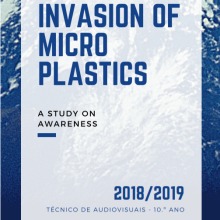
Hosted by OSOS , contributed by carla43machado on 10 April 2019
Daily news worldwide has been very clear about growing concern about the invasion of microplastics. Invasion? Yes! For a long time, marine pollution has been a constant, especially with regard to plastic pollution. What is certain is that over time this plastic will degrade, that is, it will become microplastics. So small, they end up in the organism of marine beings that confuse them with food.
In fact, this does not end here because the organism of marine beings is obviously affected by these tiny plastics. The cycle continues. The human being feeds on fish, molluscs, among other marine species. Thus, the human being ends up ingesting the marine being that already contains in its chemical bloodstream due to the ingestion of microplastics. In this way, it is also man who thickens his blood, with the resultant chemicals! How bad will it be? Do most people know about this? If they do not know, would they be able to do anything to change? Would they change consumption habits?
Marine pollution has been growing in recent decades. The increase has been observed since 1950 (5 million tons) until today (265 million in 2010).
A report released by the World Economic Forum says that if the level of plastics worldwide is maintained, by 2050 the oceans will have more plastic than fish by weight.
"Plastics have more than twenty families of polymers including polyethylene (PE), polypropylene (PP), polyvinyl chloride (PVC), polyurethane (PUR) polystyrene (PS) and polyamide (PA), which represent about 90% of world production. In addition to the main polymer, plastics contain a number of additives to improve product specifications such as ductility, hardness, durability or weather resistance. In relation to some of these additives, especially certain plasticizers, it is suspected that they are endocrine disrupters for animals and for humans.
In less than a century of existence plastic debris already accounts for about 60 to 80% of the marine litter, depending on the location. Once in the environment, macro debris undergoes mechanical degradation (erosion, abrasion), chemical (photo-oxidation, temperature, corrosion) and biological degradation by micro-organisms. The fragmentation of plastic is considered to be an infinite process and can continue to the molecular level and can lead to the continuous formation of micro plastics to nano plastic particles in the environment. (Portuguese Environment Agency, 2019). Pollution of the oceans by these fragments called microplastics, a broad category that includes all particles smaller than 5mm, is extremely worrying because of its ubiquity, persistence, and being a potential vector for exposure and transfer of persistent organic compounds of high toxicity ( Thompson et al., 2004).
Plastic fragments have been found in stomachs of various species of birds and marine mammals and fish and what has already happened in some species is the transfer of plastic particles from the digestive system to the circulatory system, and there may be damage to important organs. What is certain is that many of these species end up being ingested by humans and there are already records of the presence of microplastics in humans, fruit of the food chain. It is important to raise awareness and information to the public so that this massification of plastics ends, so that we can recover our oceans and our health. It was reported in the 'O Público' newspaper of October 23, 2018 that, resulting from a study, were found in human feces debris of up to nine different types of microplastics. Up to 20 particles per 10 grams of feces were found. A troubling study involving participants from 8 countries.
The data analysis consisted of the sorting of 11 types of plastics. "The analytical screening identified polystyrene and polyurethane plastics in two of five samples, while in the remaining samples no definitive results were obtained because of the high residual content of cellulose and fat masking the presence of microplastics." Conclusion: "The increase in plastic pollution can cause plastic contamination of food, which can affect the gastrointestinal tract. For the first time the presence of polystyrene and polyurethane microparticles were detected in samples of human feces ".
There is an urgent need for people to become aware of the health hazard they face and it is urgent that action is taken to drastically reduce the 'consumption' of plastics.
Feel
As students became involved in environmental activities, they realized that the problem of microplastics reached terrifying proportions. They understood that the awareness of VNF inhabitants about the changes that microplastics already operate in our organism is fundamental, in order to change their consumption habits. In addition to the information collected through digital research, the students also contacted the environmental awareness office of the municipality and elements belonging to environmental associations.
Imagine
The students chose to do a study among the population of the VNF and developed a survey, contemplating different age groups. The objective of the questions was precisely to understand how the inhabitants are aware of the evil that the microplastics cause and their origin. In the end they were able, indirectly, to alert the population to the problem. The students had the participation of several teachers and the environmental awareness office of the municipality.
Create
The solution to the problem can be as simple as raising the inhabitants' awareness of the severity of contamination by microplastics and, consequently, replacing plastic with other materials. We speak of simple daily gestures, such as always using the same sturdy shopping bag and drinking tap water. The students will now make a street campaign in order to reach a reasonable number of inhabitants.

